外研版(2019)必修 第二册Unit 1 Food for thought Using language课件(共29张PPT)
文档属性
| 名称 | 外研版(2019)必修 第二册Unit 1 Food for thought Using language课件(共29张PPT) | 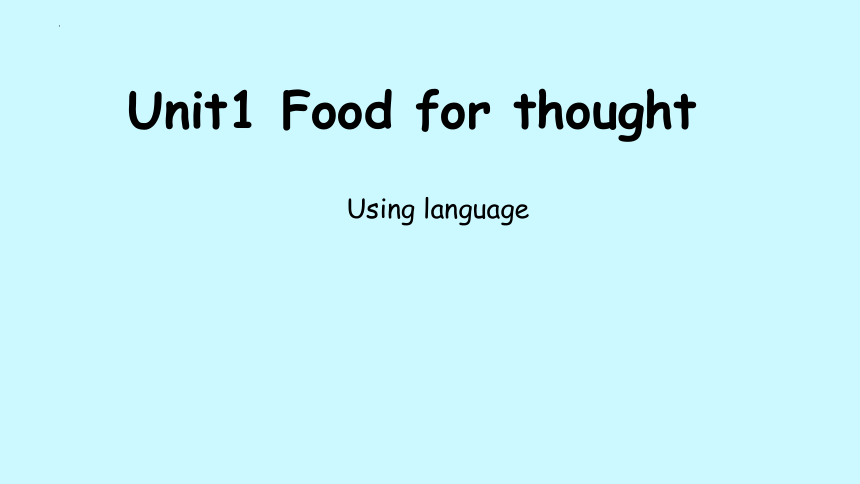 | |
| 格式 | pptx | ||
| 文件大小 | 11.4MB | ||
| 资源类型 | 教案 | ||
| 版本资源 | 外研版(2019) | ||
| 科目 | 英语 | ||
| 更新时间 | 2024-02-28 16:45:16 | ||
图片预览

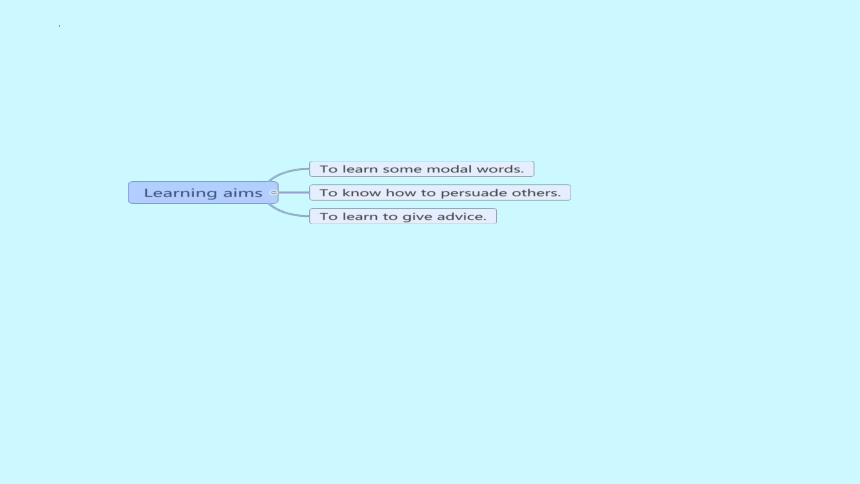
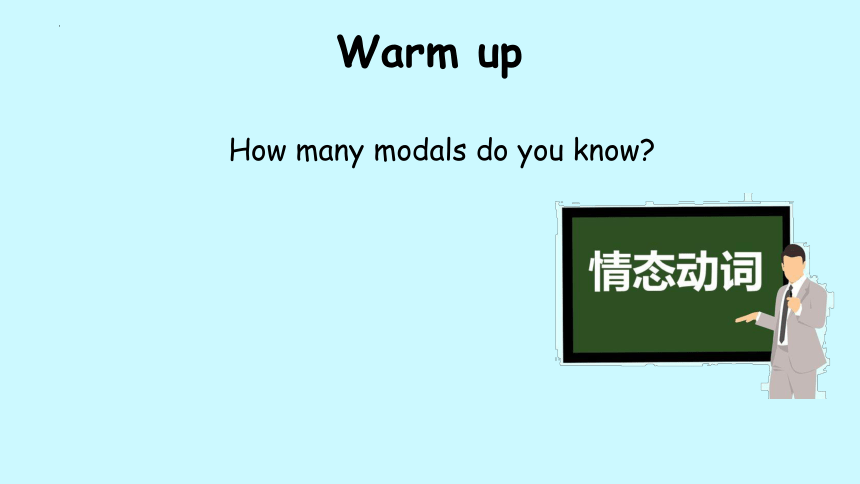
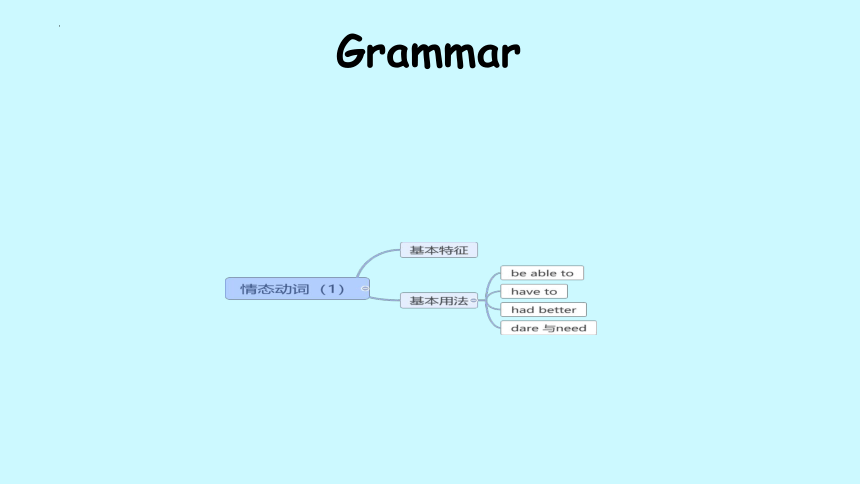
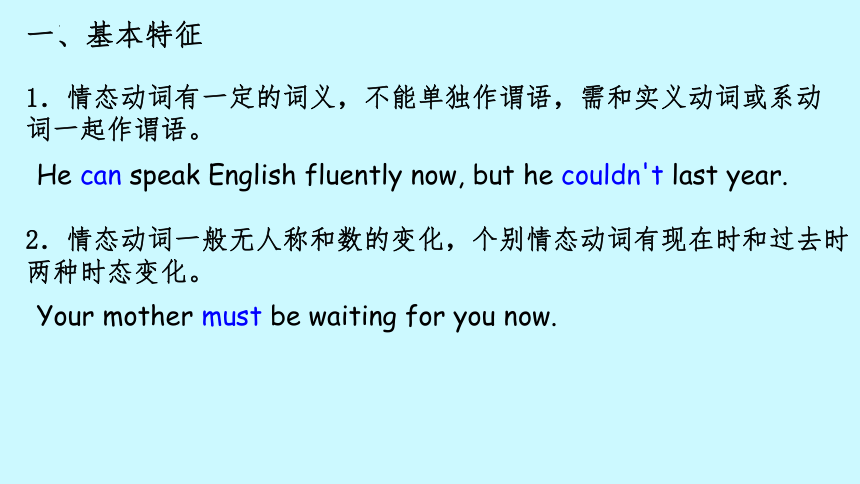
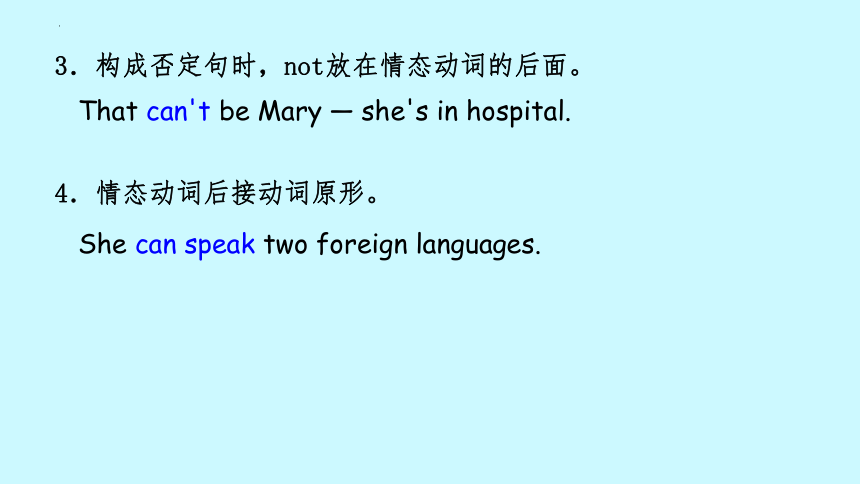
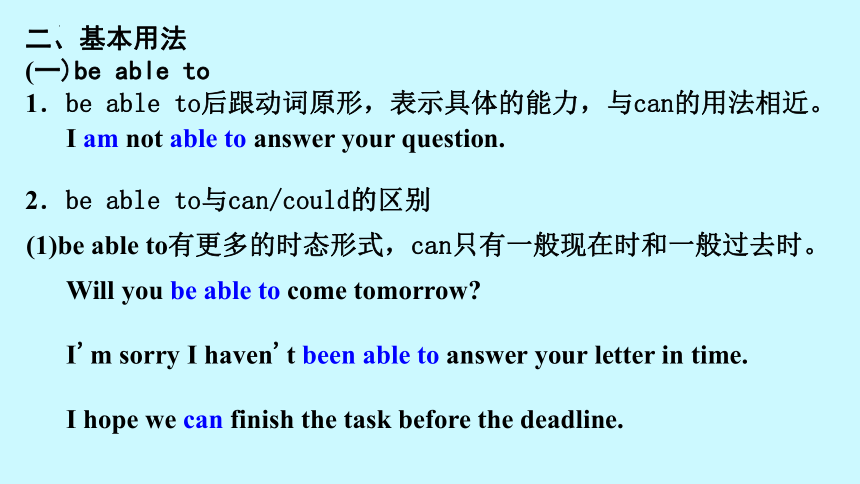
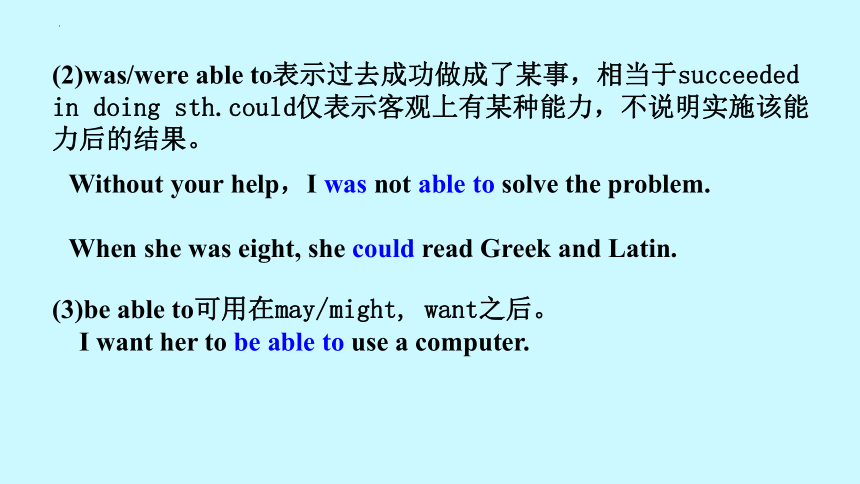
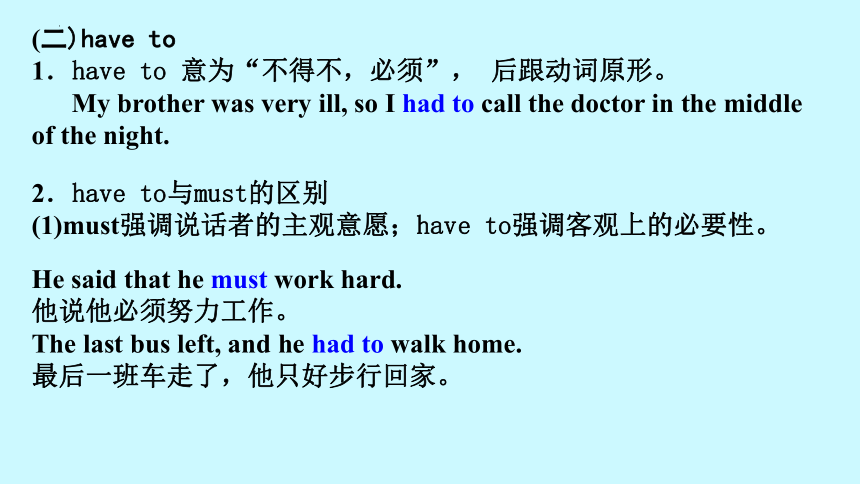
文档简介
(共29张PPT)
Unit1 Food for thought
Using language
Warm up
How many modals do you know
Grammar
一、基本特征
1.情态动词有一定的词义,不能单独作谓语,需和实义动词或系动词一起作谓语。
He can speak English fluently now, but he couldn't last year.
2.情态动词一般无人称和数的变化,个别情态动词有现在时和过去时两种时态变化。
Your mother must be waiting for you now.
3.构成否定句时,not放在情态动词的后面。
That can't be Mary — she's in hospital.
4.情态动词后接动词原形。
She can speak two foreign languages.
二、基本用法
(一)be able to
1.be able to后跟动词原形,表示具体的能力,与can的用法相近。
I am not able to answer your question.
2.be able to与can/could的区别
(1)be able to有更多的时态形式,can只有一般现在时和一般过去时。
Will you be able to come tomorrow
I'm sorry I haven't been able to answer your letter in time.
I hope we can finish the task before the deadline.
(2)was/were able to表示过去成功做成了某事,相当于succeeded in doing sth.could仅表示客观上有某种能力,不说明实施该能力后的结果。
(3)be able to可用在may/might, want之后。
I want her to be able to use a computer.
Without your help,I was not able to solve the problem.
When she was eight, she could read Greek and Latin.
He said that he must work hard.
他说他必须努力工作。
The last bus left, and he had to walk home.
最后一班车走了,他只好步行回家。
(二)have to
1.have to 意为“不得不,必须”, 后跟动词原形。
My brother was very ill, so I had to call the doctor in the middle of the night.
2.have to与must的区别
(1)must强调说话者的主观意愿;have to强调客观上的必要性。
(2)mustn't 不许,不可以,表示禁止;not have to不必
You don't have to do the work right now.
You mustn't smoke here.
(三)had better
had better 后跟动词原形,表示“最好……”,其否定式在had better 后加not。
We had better get there before it gets dark.
You'd better not talk so loudly.
(四)dare与need
1.作情态动词时,后跟动词原形,常用于否定句和疑问句中。一般不用于肯定句,无第三人称单数形式。
—Need I tell him everything
—Yes, you must./No, you needn't.
——我要告诉他一切吗?
——是的,必须。/不,没有必要。
How dare she do things like that to me
她怎么敢对我做那样的事呢?
dare有过去式形式,构成疑问句时,将其移至句首;构成否定句时,直接在其后加not。
He didn't dare (to) go there.
他不敢去那儿。
Right now you need to stay still until help comes.
现在你需要待着别动,直到有人来帮忙。
What he needs now are books.
他现在需要的是书籍。
2.作实义动词时,其否定句和疑问句的构成需借助do/did/does,后面接带to的不定式;而在疑问句和否定句中,dare后可省去to。有人称和数的变化。
Modals(1)
Look at the sentences from the reading passage. Think and work out the meaning of the words in bold.
Now talk about the function of modals. Then match the meanings to the words in bold above.
b e d c a
Underline the modals in the introduction to an app and talk about their meanings.
Complete the tips for good table manners with the correct form of the modals in activity 1.
have to
dare not
had better
needn't
be able to
Food comments
Read and match the comments to the pictures.
C
a
b
d
Underline the words that describe food in Activity 4 and put them into the table. Add more you can think of it.
shiny pink large tiny round fresh
fishy
smoky sweet spicy fruity bitter
tender cold soft sticky juicy smooth creamy
Work in pairs. Talk about your favorite food using the words you have learnt.
A: What's your favorite food
B: My favorite food is...
A: How does it look/smell/taste/feel
B: It looks/smells/tastes/feels...
Healthy eating
Pre-listening
Read the tasks in activity 7 and 8.
While listening
Listen and finish avtivity7&8.
Listen to the conversation and tick the food and drinks ordered.
Listen again and complete the notes.
fat
chemicals
amount
soft drinks
taste
harmful
Pair work
Work in pairs. Act out the conversation in activity 7.
Sum up
Homework
1, Recite the words.
2, Search for more traditional Chinese food.
Thank you !
Unit1 Food for thought
Using language
Warm up
How many modals do you know
Grammar
一、基本特征
1.情态动词有一定的词义,不能单独作谓语,需和实义动词或系动词一起作谓语。
He can speak English fluently now, but he couldn't last year.
2.情态动词一般无人称和数的变化,个别情态动词有现在时和过去时两种时态变化。
Your mother must be waiting for you now.
3.构成否定句时,not放在情态动词的后面。
That can't be Mary — she's in hospital.
4.情态动词后接动词原形。
She can speak two foreign languages.
二、基本用法
(一)be able to
1.be able to后跟动词原形,表示具体的能力,与can的用法相近。
I am not able to answer your question.
2.be able to与can/could的区别
(1)be able to有更多的时态形式,can只有一般现在时和一般过去时。
Will you be able to come tomorrow
I'm sorry I haven't been able to answer your letter in time.
I hope we can finish the task before the deadline.
(2)was/were able to表示过去成功做成了某事,相当于succeeded in doing sth.could仅表示客观上有某种能力,不说明实施该能力后的结果。
(3)be able to可用在may/might, want之后。
I want her to be able to use a computer.
Without your help,I was not able to solve the problem.
When she was eight, she could read Greek and Latin.
He said that he must work hard.
他说他必须努力工作。
The last bus left, and he had to walk home.
最后一班车走了,他只好步行回家。
(二)have to
1.have to 意为“不得不,必须”, 后跟动词原形。
My brother was very ill, so I had to call the doctor in the middle of the night.
2.have to与must的区别
(1)must强调说话者的主观意愿;have to强调客观上的必要性。
(2)mustn't 不许,不可以,表示禁止;not have to不必
You don't have to do the work right now.
You mustn't smoke here.
(三)had better
had better 后跟动词原形,表示“最好……”,其否定式在had better 后加not。
We had better get there before it gets dark.
You'd better not talk so loudly.
(四)dare与need
1.作情态动词时,后跟动词原形,常用于否定句和疑问句中。一般不用于肯定句,无第三人称单数形式。
—Need I tell him everything
—Yes, you must./No, you needn't.
——我要告诉他一切吗?
——是的,必须。/不,没有必要。
How dare she do things like that to me
她怎么敢对我做那样的事呢?
dare有过去式形式,构成疑问句时,将其移至句首;构成否定句时,直接在其后加not。
He didn't dare (to) go there.
他不敢去那儿。
Right now you need to stay still until help comes.
现在你需要待着别动,直到有人来帮忙。
What he needs now are books.
他现在需要的是书籍。
2.作实义动词时,其否定句和疑问句的构成需借助do/did/does,后面接带to的不定式;而在疑问句和否定句中,dare后可省去to。有人称和数的变化。
Modals(1)
Look at the sentences from the reading passage. Think and work out the meaning of the words in bold.
Now talk about the function of modals. Then match the meanings to the words in bold above.
b e d c a
Underline the modals in the introduction to an app and talk about their meanings.
Complete the tips for good table manners with the correct form of the modals in activity 1.
have to
dare not
had better
needn't
be able to
Food comments
Read and match the comments to the pictures.
C
a
b
d
Underline the words that describe food in Activity 4 and put them into the table. Add more you can think of it.
shiny pink large tiny round fresh
fishy
smoky sweet spicy fruity bitter
tender cold soft sticky juicy smooth creamy
Work in pairs. Talk about your favorite food using the words you have learnt.
A: What's your favorite food
B: My favorite food is...
A: How does it look/smell/taste/feel
B: It looks/smells/tastes/feels...
Healthy eating
Pre-listening
Read the tasks in activity 7 and 8.
While listening
Listen and finish avtivity7&8.
Listen to the conversation and tick the food and drinks ordered.
Listen again and complete the notes.
fat
chemicals
amount
soft drinks
taste
harmful
Pair work
Work in pairs. Act out the conversation in activity 7.
Sum up
Homework
1, Recite the words.
2, Search for more traditional Chinese food.
Thank you !
